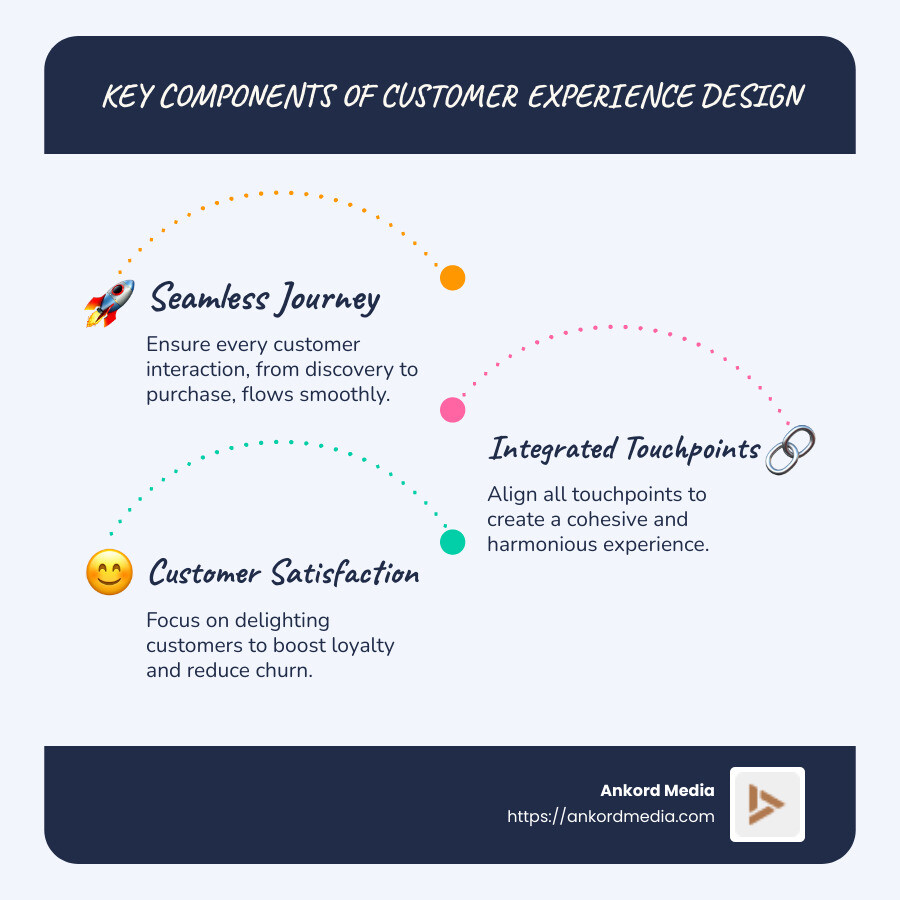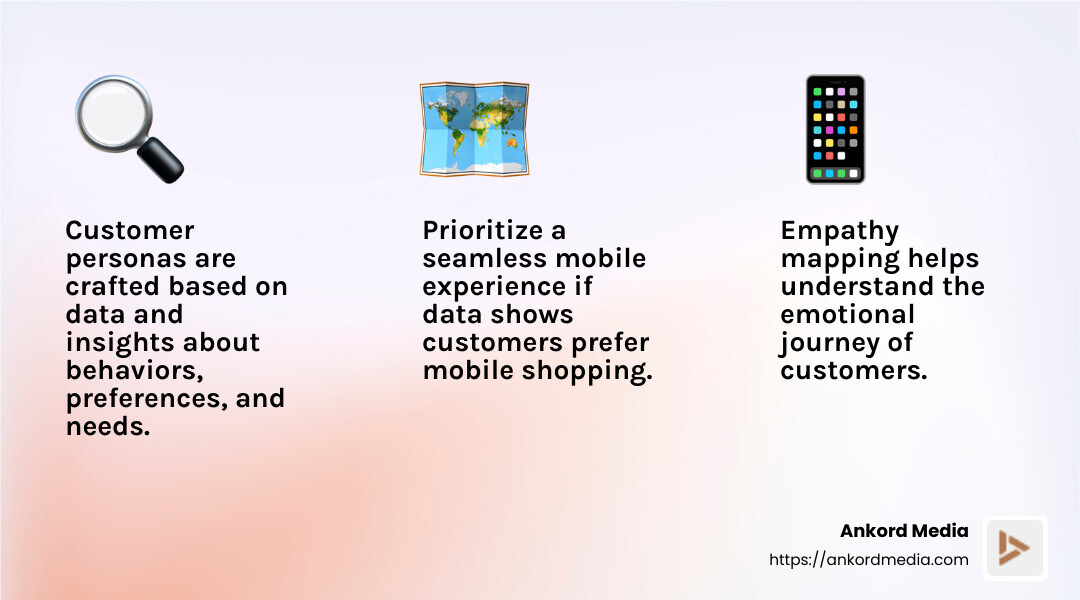The Art of Customer Experience Design: A How-To

Customer experience design is all about creating a seamless journey for each customer, from their first encounter with your brand to their final purchase and beyond. This means considering every interaction a customer has with your business and designing experiences that meet their needs and leave them delighted. Here’s what you need to know:
- It involves understanding the customer journey from start to finish.
- Focuses on creating integrated experiences where all touchpoints work harmoniously.
- Emphasizes customer satisfaction to boost loyalty and reduce churn.
By implementing effective customer experience design, companies can foster loyal relationships and create compelling narratives that resonate with their audience's needs.
I'm Milan Kordestani, and I’ve dedicated my career to mastering customer experience design. As an entrepreneur with a passion for shaping impactful brand identities, I've helped businesses not only define their customer journeys but also ensure these journeys are cohesive and engaging. Stay tuned to learn how to transform your brand’s customer experience.

Understanding Customer Experience Design
Customer experience design is all about putting the customer at the center of every decision. This approach, known as customer-centric design, ensures that every interaction, or touchpoint, is crafted to meet the customer’s needs and exceed their expectations.
The Importance of Touchpoints
Touchpoints are moments where a customer interacts with your brand. These can be anything from visiting your website, engaging with your social media, or speaking with customer service. Each touchpoint is an opportunity to delight or disappoint.
A key part of customer experience design is ensuring that every touchpoint is consistent and positive. This requires understanding how each interaction fits into the overall customer journey.
Creating a Customer Journey Map
A customer journey map is a visual representation of the customer’s experience with your brand. It outlines each step a customer takes, from first becoming aware of your brand to making a purchase and beyond.
Mapping out these journeys helps identify areas where the experience can be improved. It also highlights gaps or pain points that may cause frustration or lead to churn.
Consider this example from the hospitality industry: Hotels that focus on the entire customer journey, rather than just individual touchpoints, see a 61% increase in customer recommendations.

The Role of Empathy in Design
Designing with empathy means understanding and anticipating the emotional needs of your customers. By putting yourself in their shoes, you can create experiences that not only meet functional needs but also resonate on an emotional level.
Incorporating empathy into your customer journey map helps identify pain points that may not be obvious at first glance. This can lead to more meaningful and satisfying customer experiences, ultimately fostering loyalty.
Bringing It All Together
By focusing on touchpoints, creating detailed customer journey maps, and designing with empathy, businesses can craft a holistic customer experience. This integrated approach not only builds loyalty but also transforms customers into brand advocates.
In the next section, we'll dive into the key principles that guide successful customer experience design. Stay tuned to learn how to design experiences that truly resonate with your audience.
Key Principles of Customer Experience Design
To create a compelling customer experience design, it's crucial to establish clear design principles. These principles act as a compass, guiding your brand in crafting experiences that resonate deeply with your audience.
Design Principles
Design principles are the backbone of effective customer experience strategies. They ensure that every product and service aligns with your brand's mission and vision. These principles help maintain consistency across all customer interactions.
Some core principles include:
- Simplicity: Ensure the customer journey is easy to understand, even if it involves complex processes.
- Customer-Centricity: Design experiences that prioritize customer needs, informed by insights and feedback.
- Completeness: Each interaction should feel satisfying and complete, leaving no loose ends.
Building Customer Personas
Understanding your customers is vital. Customer personas are fictional characters that represent your target audience. They are crafted based on data and insights about your customers' behaviors, preferences, and needs.
Creating detailed personas involves:
- Collecting data through interviews, surveys, and feedback forms.
- Identifying common themes and attributes among your customers.
- Regularly updating personas to reflect changing needs and behaviors.
For instance, if your data shows that customers prefer mobile shopping, your design should prioritize a seamless mobile experience.
Empathy Mapping
Empathy mapping is a tool used to understand the emotional and psychological journey of your customers. It goes beyond identifying pain points to truly grasp what your customers feel and why.
Incorporating empathy into your design process involves:
- Putting yourself in the customer's shoes to anticipate their emotional needs.
- Identifying pain points that might not be immediately obvious.
- Designing solutions that resonate on an emotional level, fostering deeper connections.
Take a lesson from IKEA's Home Smart line, which used empathy mapping to understand how customers would interact with integrated wireless-charging furniture. By immersing themselves in the customer's world, they created products that fit seamlessly into everyday life.

By adhering to these key principles—establishing design guidelines, building customer personas, and employing empathy mapping—you set the stage for a customer experience that not only meets functional needs but also connects emotionally with your audience.
In the following section, we'll explore how to implement a customer experience design strategy effectively, ensuring that your efforts translate into tangible results.
Implementing a Customer Experience Design Strategy
Creating a successful customer experience design means turning your strategic insights into real-world actions. This involves gathering customer feedback, ensuring seamless experiences, and building customer loyalty.
Listen to Customer Feedback
Customer feedback is gold. It tells you what works and what doesn't. Use surveys, interviews, and feedback forms to gather insights. This data helps you understand customer needs and refine your strategy.
- Surveys: Quick and easy way to gather opinions.
- Interviews: Dive deeper into customer thoughts and feelings.
- Feedback Forms: Collect ongoing input from customers.
For example, Netflix uses customer feedback to tweak its recommendation algorithms, ensuring that users find content they love.
Ensure a Seamless Experience
A seamless experience means customers move smoothly from one interaction to the next without hiccups. Every touchpoint should be intuitive and efficient.
Here’s how to achieve that:
- Consistent Design: Maintain the same look and feel across all platforms.
- Simple Navigation: Make it easy for customers to find what they need.
- Quick Support: Offer fast help through chatbots or live agents.
Amazon excels at this by providing a simple checkout process and easy access to customer service.
Build Customer Loyalty
Loyal customers are your best advocates. They return for repeat purchases and spread the word about your brand. Focus on creating memorable experiences that keep them coming back.
- Personalized Offers: Tailor promotions to individual preferences.
- Loyalty Programs: Reward repeat customers with discounts or perks.
- Referral Incentives: Encourage customers to bring in friends for rewards.
Starbucks' loyalty program is a great example. It offers personalized rewards based on customer purchase history, which keeps customers engaged and coming back for more.
By focusing on these areas, you can create a customer experience that not only meets expectations but exceeds them, fostering a loyal customer base that supports your brand's growth.
In the next section, we’ll dive into how to measure the impact of your customer experience design efforts, ensuring that your strategy delivers the desired results.
Measuring the Impact of Customer Experience Design
Understanding the impact of your customer experience design is crucial. It's not just about creating great experiences; it's about proving they work. Let's explore how you can measure success using KPIs, customer satisfaction, and customer churn.
Key Performance Indicators (KPIs)
KPIs are your roadmap to success. They help you track progress and measure the effectiveness of your strategies. Here are some KPIs to consider:
- Customer Satisfaction Score (CSAT): Measures how happy customers are with your product or service.
- Net Promoter Score (NPS): Gauges customer loyalty by asking them how likely they are to recommend your brand.
- Customer Effort Score (CES): Assesses how easy it is for customers to interact with your company.
For example, companies like Robinhood use KPIs like NPS to ensure their customer experience remains transparent and simple, keeping users engaged.
Customer Satisfaction
Happy customers are your best asset. They keep coming back and bring friends with them. To boost customer satisfaction:
- Listen to Feedback: Regularly collect and act on customer opinions.
- Personalize Experiences: Tailor interactions to meet individual needs.
- Resolve Issues Quickly: Address problems as soon as they arise.
Noom, a successful weight loss app, leverages feedback to personalize its offerings, resulting in a 3,000 percent sales growth over four years.
Customer Churn
Churn is the enemy of growth. It's the rate at which customers stop doing business with you. To reduce churn:
- Identify Pain Points: Use empathy mapping to understand customer frustrations.
- Improve Support: Provide excellent customer service at every touchpoint.
- Engage Regularly: Keep in touch with customers through newsletters and updates.
By focusing on reducing churn, companies can maintain a stable customer base and encourage long-term relationships.
Measuring the impact of your customer experience design is about more than just numbers. It's about understanding what drives your customers and continuously improving their journey. In the next section, we'll tackle some frequently asked questions about customer experience design to further improve your strategy.
Frequently Asked Questions about Customer Experience Design
What is design in customer experience?
Customer experience design is all about crafting an integrated journey that customers love. It's like being a tour guide for your brand, ensuring every step is smooth and enjoyable. Think of it as designing a path where every interaction feels right, from the first hello to the final thank you.
Imagine walking into your favorite coffee shop. From the welcoming aroma to the friendly barista who knows your order by heart, every touchpoint is designed to make you feel valued.
What is the difference between CX and UX?
Customer Experience (CX) and User Experience (UX) often get mixed up, but they're not the same.
CX is about the big picture—a holistic view of all interactions a customer has with your brand. It's the entire journey, from seeing an ad to using the product and getting support if needed.
UX, on the other hand, zooms in on specific interactions. It's like focusing on how easy it is to steer a website or use an app. UX is crucial for ensuring each digital touchpoint works without a hitch.
To put it simply, CX is the whole movie, while UX is each scene. Both are important, but they play different roles in creating a seamless experience.
What is the role of a CX designer?
A CX designer is like an architect for customer interactions. Their job is to improve touchpoints and ensure a seamless experience. They work behind the scenes to make sure every customer feels understood and valued.
A great example is how a CX designer might use customer journey maps to pinpoint where improvements are needed. By focusing on empathy and understanding customer needs, they can tailor experiences that resonate deeply with users.
CX designers are the storytellers of a brand, crafting narratives that keep customers engaged and coming back for more.
Now that we've covered some common questions, let's dive deeper into how Ankord Media can help you build authentic engagement and strategic branding.
Conclusion
At Ankord Media, we believe that customer experience design is an art that combines authentic engagement with strategic branding. Our approach is simple: put the customer first and craft experiences that resonate on a personal level.
Authentic Engagement
Engaging with customers authentically means creating connections that are genuine and meaningful. We focus on understanding who your customers are, what they need, and how they feel. By using empathy mapping and customer personas, we ensure that every interaction is custom to meet those needs.
Consider the success stories of companies like Bang Energy and Noom. They have mastered the art of engagement by building trust and loyalty through influencer programs that speak directly to their target audiences. These examples show that when you connect authentically, customers respond positively.
Strategic Branding
Strategic branding is about more than just a logo or a catchy slogan. It's about crafting a narrative that aligns with your company's values and vision. At Ankord Media, we specialize in changing bold ideas into success stories by focusing on the big picture.
Our strategic branding efforts ensure that every touchpoint—from your website to social media interactions—is consistent and impactful. By blending cutting-edge design with the latest technology, we create digital experiences that not only meet but exceed customer expectations.
Partnering for Success
We pride ourselves on partnering with visionary clients to turn their dreams into reality. Whether you're a startup looking to make a mark or an established brand aiming to improve your customer experience, we're here to help.
Your brand lives online. Let us help you craft a seamless journey that keeps customers coming back for more. Together, we can create a customer experience that is both memorable and effective.
Ready to lift your brand with authentic customer connections? Learn more about our services at Ankord Media. Let's build experiences that captivate and convert.

